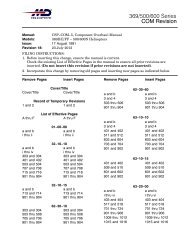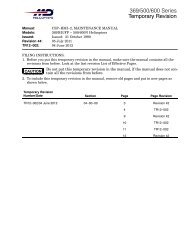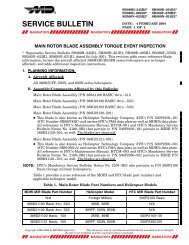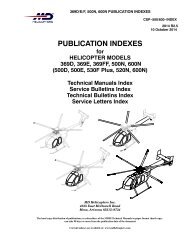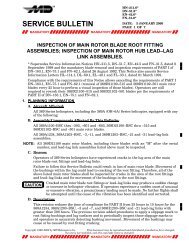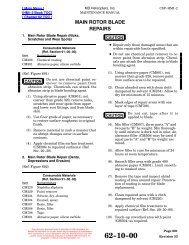TEMPORARY REVISION - MD Helicopters
TEMPORARY REVISION - MD Helicopters
TEMPORARY REVISION - MD Helicopters
Create successful ePaper yourself
Turn your PDF publications into a flip-book with our unique Google optimized e-Paper software.
<strong>MD</strong> <strong>Helicopters</strong>, Inc.500 Series − Basic HMICSP−H−2C. Jacking(Ref. Figure 2−2) Provisions for jacking thehelicopter are provided by two forward (side)jacking point fittings and an aft jacking pad.NOTE: When the helicopter is jacked from oneside only, a cushioned saddle-type supportshould be placed under the tailboom at theboom jacking fitting location for extra stability.(1). Install jacking fittings (2, Table 2−2) inthe fuselage jacking points. Secure thejacking fittings with the locking pinsthat are secured to the fuel cell accessdoors.(2). Place suitable jacks under jackingfittings, and under aft jacking pad.(3). Raise the helicopter to the desiredheight.D. Leveling(Ref. Figure 2−2) Leveling is accomplished bycausing a plumb bob to intersect registermarks inscribed on the target plate located onthe cargo compartment floorNOTE: Access to plumb line support bracketand target plate on floor of passenger/cargocompartment requires removal of trim onright side of controls tunnel and floor carpetin aft compartment.(1). Suspend plumb line from bracket onright side of controls tunnel at Sta.92.64, BL +6.20.(2). Adjust plumb line swing to levelingtarget plate on floor of passenger/cargocompartment.(3). With weight of helicopter supported byload cells or jacks, adjust appropriatejack until plumb line is centered.(4). Adjust side jacks to level helicopterlaterally.(5). Adjust tailboom jack to level helicopterlongitudinally.(6). Recheck lateral and longitudinal levelsuntil the plumb bob exactly aligns withmarks on target plate.(7). After leveling helicopter, remove plumbbob, reinstall trim and carpet and closecompartment door.E. Parking(Ref. Figure 2−4) To park the helicopter forshort intervals, perform steps (1). thru (4). Forlonger duration parking, also perform steps(5). and (6).To prevent rotor damage fromCAUTIONblade flapping (droop stoppounding) as a result of air turbulence fromother aircraft landing or taking off, or suddenwind gusts, rotor blades should be securedwhenever the aircraft is parked.(1). Locate the helicopter slightly more thanblade clearance from near−by objects.(2). Apply friction to lock the cyclic stick sothat the friction control knobs arepositioned on the lateral and longitudinaltravel stop guides as follows:neutral laterally (center of slot), andone−third from full aft longitudinally(one−third up from bottom of slot).NOTE: If not all ready accomplished, apply apaint mark on the edge of the guide to locatethe neutral position for future reference.(3). Locate the helicopter on the most levelground available.(4). Secure the main rotor blades as follows.(a). Turn blades until they are at 45degrees angle to the fuselage centerline.(b). Install blade socks (3, Table 2−2) onall blades.When securing tiedown cords,CAUTIONtake up slack but do not exertbending loads on blades.(c). Secure blade sock tiedown cords tofuselage jacking fittings.(5). Install engine air inlet cover assembly(46 on engine air inlet front fairing.(6). Install engine exhaust outlet cover (47)on exhaust tailpipes.F. Mooring(Ref. Figure 2−4) Whenever severe stormconditions or wind velocities higher than 40Page 2−5TR09−001



